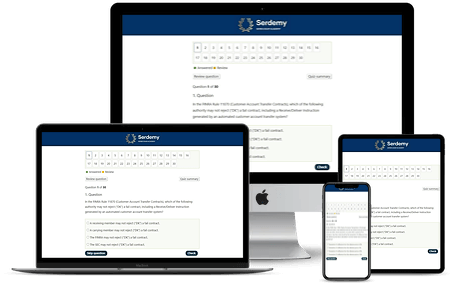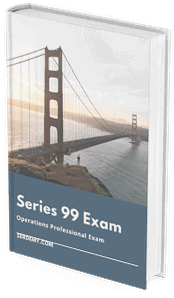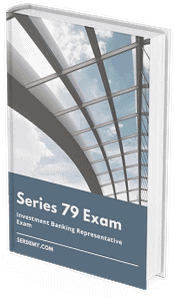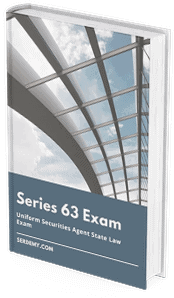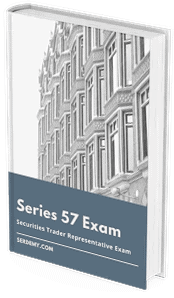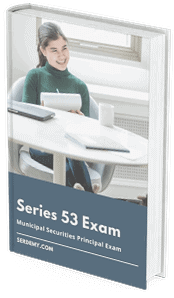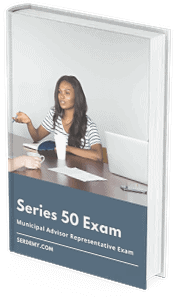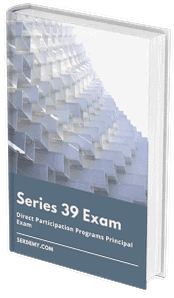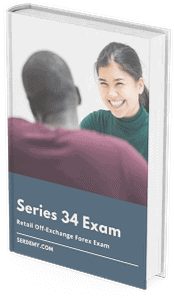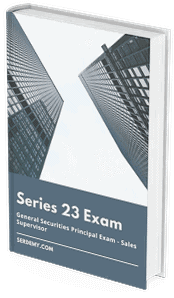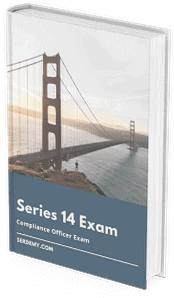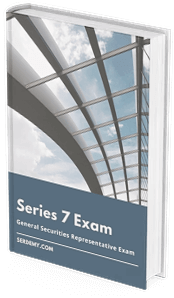Quiz-summary
0 of 30 questions completed
Questions:
- 1
- 2
- 3
- 4
- 5
- 6
- 7
- 8
- 9
- 10
- 11
- 12
- 13
- 14
- 15
- 16
- 17
- 18
- 19
- 20
- 21
- 22
- 23
- 24
- 25
- 26
- 27
- 28
- 29
- 30
Information
Premium Practice Questions
You have already completed the quiz before. Hence you can not start it again.
Quiz is loading...
You must sign in or sign up to start the quiz.
You have to finish following quiz, to start this quiz:
Results
0 of 30 questions answered correctly
Your time:
Time has elapsed
Categories
- Not categorized 0%
- 1
- 2
- 3
- 4
- 5
- 6
- 7
- 8
- 9
- 10
- 11
- 12
- 13
- 14
- 15
- 16
- 17
- 18
- 19
- 20
- 21
- 22
- 23
- 24
- 25
- 26
- 27
- 28
- 29
- 30
- Answered
- Review
-
Question 1 of 30
1. Question
An assessment of a recent trade at a proprietary trading firm reveals a potential error. At 10:15 AM ET, a trader named Kenji executed a sell order for 1,000 shares of Quantum Dynamics Corp. (QDC), an NMS stock. The order was filled at a price of $39.95 per share. Immediately prior to this execution, the consolidated last sale price for QDC was exactly $50.00. The firm’s compliance officer is now evaluating whether this trade can be submitted for review. Based on FINRA Rule 11890, what is the proper assessment of this transaction?
Correct
The reference price for determining a clearly erroneous transaction is the consolidated last sale price immediately prior to the trade in question, which is $50.00. According to FINRA Rule 11890, for NMS stocks priced over $25.00 up to and including $50.00, the numerical guideline for a transaction to be considered for review is a deviation of 5% or more from the reference price. The calculation to determine the lower boundary of the acceptable price range is: Reference Price x (1 – Numerical Guideline Percentage) \[\$50.00 \times (1 – 0.05) = \$50.00 \times 0.95 = \$47.50\] The transaction in question was executed at $39.95. Since the execution price of $39.95 is below the calculated threshold of $47.50, the trade deviates from the reference price by more than the applicable 5% guideline. Therefore, the transaction is eligible to be reviewed as a clearly erroneous transaction. A party to the transaction must submit a written complaint to FINRA Market Operations within the specified time frame, which is generally 30 minutes from the time of execution. The rule provides a framework for exchanges and FINRA to review and potentially nullify or adjust trades that are determined to be clearly erroneous, ensuring market integrity and fairness by correcting obvious pricing errors that could result from system malfunctions or human error. The determination is based on the numerical guidelines, and other factors such as the time of day or order size are not the primary determinants for eligibility for review.
Incorrect
The reference price for determining a clearly erroneous transaction is the consolidated last sale price immediately prior to the trade in question, which is $50.00. According to FINRA Rule 11890, for NMS stocks priced over $25.00 up to and including $50.00, the numerical guideline for a transaction to be considered for review is a deviation of 5% or more from the reference price. The calculation to determine the lower boundary of the acceptable price range is: Reference Price x (1 – Numerical Guideline Percentage) \[\$50.00 \times (1 – 0.05) = \$50.00 \times 0.95 = \$47.50\] The transaction in question was executed at $39.95. Since the execution price of $39.95 is below the calculated threshold of $47.50, the trade deviates from the reference price by more than the applicable 5% guideline. Therefore, the transaction is eligible to be reviewed as a clearly erroneous transaction. A party to the transaction must submit a written complaint to FINRA Market Operations within the specified time frame, which is generally 30 minutes from the time of execution. The rule provides a framework for exchanges and FINRA to review and potentially nullify or adjust trades that are determined to be clearly erroneous, ensuring market integrity and fairness by correcting obvious pricing errors that could result from system malfunctions or human error. The determination is based on the numerical guidelines, and other factors such as the time of day or order size are not the primary determinants for eligibility for review.
-
Question 2 of 30
2. Question
Consider a scenario where Anika, a trader at a proprietary trading firm, is reviewing an execution in OmniCorp (OMNI), an NMS stock. At 11:15 a.m. ET, the consolidated last sale for OMNI was $22.50. Immediately following this, her firm’s automated trading system executed a large sell order for OMNI at a price of $20.20 per share. Anika flags the trade for review, believing it may be clearly erroneous. Assuming a FINRA officer reviews the transaction and concurs that it is clearly erroneous under the provisions of Rule 11890, what is the most likely regulatory outcome for this specific transaction?
Correct
The reference price for determining if a transaction is clearly erroneous is the consolidated last sale immediately prior to the transaction, which is $22.50. According to FINRA Rule 11890, for NMS stocks priced up to and including $25.00, the numerical guideline for a clearly erroneous transaction is 10% away from the reference price. First, calculate the numerical threshold: \[ \$22.50 \times 10\% = \$2.25 \] Next, determine the price range that would be considered clearly erroneous. A trade is clearly erroneous if it occurs at a price that is at or more than the numerical threshold away from the reference price. Lower Boundary: \( \$22.50 – \$2.25 = \$20.25 \) Upper Boundary: \( \$22.50 + \$2.25 = \$24.75 \) Any trade at or below $20.25, or at or above $24.75, is presumed to be clearly erroneous. The transaction in question occurred at $20.20, which is below the lower boundary of $20.25. Therefore, it qualifies as a clearly erroneous transaction. When a transaction is deemed clearly erroneous but does not meet the criteria for nullification (which is typically reserved for more severe deviations, such as 30% or more for stocks in this price range), the standard procedure is to adjust the execution price. The price is adjusted to the reference price, plus or minus the numerical guideline. In this case, because the erroneous trade was a sale below the reference price, the execution price is adjusted up to the lower boundary of the non-erroneous range. The adjusted price would therefore be $20.25. This process ensures that the transaction is brought back to the limit of what would have been considered a valid execution under the rule, rather than completely cancelling the trade or adjusting it back to the original reference price.
Incorrect
The reference price for determining if a transaction is clearly erroneous is the consolidated last sale immediately prior to the transaction, which is $22.50. According to FINRA Rule 11890, for NMS stocks priced up to and including $25.00, the numerical guideline for a clearly erroneous transaction is 10% away from the reference price. First, calculate the numerical threshold: \[ \$22.50 \times 10\% = \$2.25 \] Next, determine the price range that would be considered clearly erroneous. A trade is clearly erroneous if it occurs at a price that is at or more than the numerical threshold away from the reference price. Lower Boundary: \( \$22.50 – \$2.25 = \$20.25 \) Upper Boundary: \( \$22.50 + \$2.25 = \$24.75 \) Any trade at or below $20.25, or at or above $24.75, is presumed to be clearly erroneous. The transaction in question occurred at $20.20, which is below the lower boundary of $20.25. Therefore, it qualifies as a clearly erroneous transaction. When a transaction is deemed clearly erroneous but does not meet the criteria for nullification (which is typically reserved for more severe deviations, such as 30% or more for stocks in this price range), the standard procedure is to adjust the execution price. The price is adjusted to the reference price, plus or minus the numerical guideline. In this case, because the erroneous trade was a sale below the reference price, the execution price is adjusted up to the lower boundary of the non-erroneous range. The adjusted price would therefore be $20.25. This process ensures that the transaction is brought back to the limit of what would have been considered a valid execution under the rule, rather than completely cancelling the trade or adjusting it back to the original reference price.
-
Question 3 of 30
3. Question
Consider a scenario where Apex Trading is acting as a passive market maker under SEC Rule 103 for the initial public offering of Quantum Dynamics Inc. (QDI). The National Best Bid (NBB) for QDI is $25.10, and Apex has its passive bid displayed at $25.10. A trade for QDI then executes on another exchange at $25.05, and immediately following this trade, the NBB for QDI is updated to $25.05. To remain in compliance with Regulation M, what is the required action for Apex Trading regarding its bid?
Correct
The scenario involves SEC Regulation M, specifically Rule 103, which governs passive market making. A passive market maker is a distribution participant that is permitted to continue making a market in a security during the restricted period of an offering, but with significant limitations to prevent manipulative activity that could artificially inflate the stock price. The core principle is that a passive market maker cannot lead the market; it can only follow. The highest bid a passive market maker can enter is limited to the highest current independent bid, which is the highest bid for the security from a market maker who is not a distribution participant. In this situation, the initial National Best Bid (NBB) is $25.10, and this is the highest independent bid. Therefore, the passive market maker, Apex Trading, correctly places its bid at $25.10. When a trade occurs at $25.05 and the NBB subsequently drops to $25.05, the highest independent bid is now $25.05. According to Rule 103, the passive market maker’s bid cannot be higher than the current highest independent bid. Consequently, Apex Trading must immediately lower its bid to a price no higher than the new NBB of $25.05 to remain in compliance. Maintaining the bid at $25.10 would mean Apex’s bid is now above the highest independent bid, which would constitute impermissible, active market making intended to push the price up, violating the spirit and letter of Rule 103. The rule is designed to provide liquidity without allowing the market maker to create upward price pressure on the security it is helping to distribute.
Incorrect
The scenario involves SEC Regulation M, specifically Rule 103, which governs passive market making. A passive market maker is a distribution participant that is permitted to continue making a market in a security during the restricted period of an offering, but with significant limitations to prevent manipulative activity that could artificially inflate the stock price. The core principle is that a passive market maker cannot lead the market; it can only follow. The highest bid a passive market maker can enter is limited to the highest current independent bid, which is the highest bid for the security from a market maker who is not a distribution participant. In this situation, the initial National Best Bid (NBB) is $25.10, and this is the highest independent bid. Therefore, the passive market maker, Apex Trading, correctly places its bid at $25.10. When a trade occurs at $25.05 and the NBB subsequently drops to $25.05, the highest independent bid is now $25.05. According to Rule 103, the passive market maker’s bid cannot be higher than the current highest independent bid. Consequently, Apex Trading must immediately lower its bid to a price no higher than the new NBB of $25.05 to remain in compliance. Maintaining the bid at $25.10 would mean Apex’s bid is now above the highest independent bid, which would constitute impermissible, active market making intended to push the price up, violating the spirit and letter of Rule 103. The rule is designed to provide liquidity without allowing the market maker to create upward price pressure on the security it is helping to distribute.
-
Question 4 of 30
4. Question
The trading desk at Momentum Alpha Partners is analyzing a situation involving Innovate Robotics Corp. (INRB). INRB priced a secondary offering of its common stock after the market close on Tuesday, April 16th. A trader on the desk, Kai, had established a new short position in INRB on Monday, April 15th, believing the stock was overvalued. Momentum Alpha Partners was subsequently allocated shares in the offering. According to SEC Regulation M, what is the direct consequence of Kai’s short sale on the firm’s ability to participate in the INRB offering?
Correct
The primary regulation governing this scenario is SEC Regulation M, specifically Rule 105, which addresses short selling in connection with a public offering. The purpose of this rule is to prevent manipulative short selling activity that could artificially depress the market price of a security just before it is priced for an offering, thereby allowing the short seller to purchase the offered securities at a lower price. The rule establishes a restricted period. This period begins five business days before the pricing of the offered securities and ends with the pricing. In this scenario, the offering was priced on Tuesday evening. Counting back five business days (Monday, Friday, Thursday, Wednesday, Tuesday of the previous week), we can determine the start of the restricted period. The trader’s short sale on Monday falls squarely within this five-business-day window. According to Rule 105, it is unlawful for any person to purchase offered securities from an underwriter or broker or dealer participating in the offering if such person sold short the security that is the subject of the offering during the restricted period. Because the firm’s trader executed a short sale during this period, the firm itself is prohibited from purchasing the shares it was allocated in the secondary offering. There are specific exceptions to this rule, such as the bona fide purchase exception, but the facts presented in the scenario do not indicate that the conditions for any exception have been met. Therefore, the direct and immediate consequence is a prohibition on the purchase.
Incorrect
The primary regulation governing this scenario is SEC Regulation M, specifically Rule 105, which addresses short selling in connection with a public offering. The purpose of this rule is to prevent manipulative short selling activity that could artificially depress the market price of a security just before it is priced for an offering, thereby allowing the short seller to purchase the offered securities at a lower price. The rule establishes a restricted period. This period begins five business days before the pricing of the offered securities and ends with the pricing. In this scenario, the offering was priced on Tuesday evening. Counting back five business days (Monday, Friday, Thursday, Wednesday, Tuesday of the previous week), we can determine the start of the restricted period. The trader’s short sale on Monday falls squarely within this five-business-day window. According to Rule 105, it is unlawful for any person to purchase offered securities from an underwriter or broker or dealer participating in the offering if such person sold short the security that is the subject of the offering during the restricted period. Because the firm’s trader executed a short sale during this period, the firm itself is prohibited from purchasing the shares it was allocated in the secondary offering. There are specific exceptions to this rule, such as the bona fide purchase exception, but the facts presented in the scenario do not indicate that the conditions for any exception have been met. Therefore, the direct and immediate consequence is a prohibition on the purchase.
-
Question 5 of 30
5. Question
An assessment of a trading communication from Alistair, a trader at Momentum Prime Trading, is required to determine compliance with FINRA rules. Alistair posted the following message in a widely used institutional chat room: “Looking for ZNTR. We’ve been active buyers today around \( \$2.15 \). Happy to take on a decent block.” Immediately after, a trader from Apex Capital sends an order to sell 10,000 shares of Zentronix Corp. (ZNTR) to Momentum Prime at \( \$2.15 \). Momentum Prime rejects the execution. Which of the following statements correctly evaluates Momentum Prime’s action under FINRA Rule 5220 (Offers at Stated Prices)?
Correct
The firm’s action did not constitute a violation. The determinative factor is whether the communication can be reasonably construed as a firm offer at a stated price under FINRA Rule 5220. The message stated the firm was buying “around \( \$2.15 \)”. The word “around” is qualifying language that makes the price an approximation, not a definite, stated price at which the firm is obligated to trade. Furthermore, the phrase “happy to take on a decent block” is subjective and does not specify a firm size. For Rule 5220 to apply, the offer must be firm in its terms. This communication is more properly characterized as a non-binding Indication of Interest (IOI). An IOI is used to solicit interest or probe for liquidity without making a firm commitment to trade. Because the communication lacked the necessary firmness in both price and size, it did not create an obligation for the firm to execute the trade presented to it. Therefore, rejecting the 10,000 share order was permissible and not a violation of the rule regarding offers at stated prices. This rule is in place to prevent firms from publishing misleading quotations to entice order flow without the intention of honoring those prices, but it also allows for more general, non-binding communications like IOIs.
Incorrect
The firm’s action did not constitute a violation. The determinative factor is whether the communication can be reasonably construed as a firm offer at a stated price under FINRA Rule 5220. The message stated the firm was buying “around \( \$2.15 \)”. The word “around” is qualifying language that makes the price an approximation, not a definite, stated price at which the firm is obligated to trade. Furthermore, the phrase “happy to take on a decent block” is subjective and does not specify a firm size. For Rule 5220 to apply, the offer must be firm in its terms. This communication is more properly characterized as a non-binding Indication of Interest (IOI). An IOI is used to solicit interest or probe for liquidity without making a firm commitment to trade. Because the communication lacked the necessary firmness in both price and size, it did not create an obligation for the firm to execute the trade presented to it. Therefore, rejecting the 10,000 share order was permissible and not a violation of the rule regarding offers at stated prices. This rule is in place to prevent firms from publishing misleading quotations to entice order flow without the intention of honoring those prices, but it also allows for more general, non-binding communications like IOIs.
-
Question 6 of 30
6. Question
Anika, a proprietary trader at Apex Trading, is reviewing a recent execution in NMS stock QRST. QRST has been trading in a stable range between $80.10 and $80.25 for the past hour. Due to a momentary, severe data feed corruption from a third-party vendor that affected multiple market participants, her firm’s system executed a 10,000-share sell order in QRST at $71.82. Immediately following the execution, the consolidated tape shows subsequent trades returning to the $80.15 level. The counterparty to the trade was another member firm. According to FINRA Rule 11890, what is the most likely determination and required action regarding this transaction?
Correct
1. Determine the reference price: The consolidated last sale price for stock QRST immediately prior to the disputed transaction was approximately $80.15. 2. Calculate the percentage deviation of the transaction price from the reference price: \[ \text{Deviation} = \frac{|\text{Reference Price} – \text{Transaction Price}|}{\text{Reference Price}} \] \[ \text{Deviation} = \frac{|\$80.15 – \$71.82|}{\$80.15} = \frac{\$8.33}{\$80.15} \approx 0.1039 \] 3. Convert the deviation to a percentage: \(0.1039 \times 100 = 10.39\%\). 4. Apply the Numerical Guideline from FINRA Rule 11890: For an NMS stock with a reference price over $50.00, a transaction is presumptively clearly erroneous if it occurs at a price that deviates by 10% or more. 5. Conclusion: The calculated deviation of 10.39% exceeds the 10% threshold. Therefore, the transaction is presumptively clearly erroneous. The appropriate action is for the firm to file a complaint, after which a FINRA officer will review the facts and likely nullify the trade. This scenario is governed by FINRA Rule 11890, which establishes procedures for reviewing and acting upon transactions that are determined to be clearly erroneous. The rule’s purpose is to maintain a fair and orderly market by providing a mechanism to address trades executed at prices that are obviously incorrect, often due to system malfunctions or human error. To assess whether a trade is clearly erroneous, a reference price is established, which is typically the consolidated last sale price immediately preceding the trade in question. The percentage deviation between the transaction price and this reference price is then compared against a set of numerical guidelines. For NMS securities priced over $50.00, the guideline is a deviation of 10% or more. Since the trade in this scenario deviated by more than 10% and was caused by a verifiable system issue, it meets the criteria. A member firm must file a written complaint with FINRA Market Operations, generally within 30 minutes of the execution. A FINRA officer will then review the complaint and has the authority to declare the trade null and void, effectively canceling it, or to adjust the price to a level that is within the numerical guidelines.
Incorrect
1. Determine the reference price: The consolidated last sale price for stock QRST immediately prior to the disputed transaction was approximately $80.15. 2. Calculate the percentage deviation of the transaction price from the reference price: \[ \text{Deviation} = \frac{|\text{Reference Price} – \text{Transaction Price}|}{\text{Reference Price}} \] \[ \text{Deviation} = \frac{|\$80.15 – \$71.82|}{\$80.15} = \frac{\$8.33}{\$80.15} \approx 0.1039 \] 3. Convert the deviation to a percentage: \(0.1039 \times 100 = 10.39\%\). 4. Apply the Numerical Guideline from FINRA Rule 11890: For an NMS stock with a reference price over $50.00, a transaction is presumptively clearly erroneous if it occurs at a price that deviates by 10% or more. 5. Conclusion: The calculated deviation of 10.39% exceeds the 10% threshold. Therefore, the transaction is presumptively clearly erroneous. The appropriate action is for the firm to file a complaint, after which a FINRA officer will review the facts and likely nullify the trade. This scenario is governed by FINRA Rule 11890, which establishes procedures for reviewing and acting upon transactions that are determined to be clearly erroneous. The rule’s purpose is to maintain a fair and orderly market by providing a mechanism to address trades executed at prices that are obviously incorrect, often due to system malfunctions or human error. To assess whether a trade is clearly erroneous, a reference price is established, which is typically the consolidated last sale price immediately preceding the trade in question. The percentage deviation between the transaction price and this reference price is then compared against a set of numerical guidelines. For NMS securities priced over $50.00, the guideline is a deviation of 10% or more. Since the trade in this scenario deviated by more than 10% and was caused by a verifiable system issue, it meets the criteria. A member firm must file a written complaint with FINRA Market Operations, generally within 30 minutes of the execution. A FINRA officer will then review the complaint and has the authority to declare the trade null and void, effectively canceling it, or to adjust the price to a level that is within the numerical guidelines.
-
Question 7 of 30
7. Question
Kenji, a proprietary trader at Momentum Traders, is in a coffee shop when he overhears two institutional sales traders from Goliath Brokerage discussing the logistics of a 500,000-share buy order for InnovateCore Inc. (INVC), a thinly-traded NMS stock. They mention the order will be worked over the next two hours. Kenji, whose firm has no relationship with Goliath Brokerage, immediately returns to his desk and, for his firm’s proprietary account, purchases a large volume of near-term, out-of-the-money INVC call options. Which of the following best assesses Kenji’s actions under FINRA rules?
Correct
1. Identify the core information: Kenji gains knowledge of an impending 500,000-share block transaction in INVC stock. 2. Characterize the information: This knowledge is material, as a 500,000-share order in a thinly-traded stock will almost certainly affect its price. It is also non-public, as it was obtained from a private conversation and not disseminated to the market. 3. Analyze the action: Kenji uses this information to trade for his firm’s proprietary account before the block trade is executed. He specifically trades a related financial instrument (call options) to profit from the anticipated price movement caused by the block trade. 4. Apply the relevant regulation: FINRA Rule 5270, Front Running of Block Transactions, explicitly prohibits a member from trading a security or a related financial instrument for its own account or soliciting an order from another person when the member has material, non-public market information concerning an imminent block transaction in that security. 5. Conclusion: Kenji’s purchase of call options based on the overheard information about the imminent block buy order is a direct violation of FINRA Rule 5270. FINRA Rule 5270 is designed to prevent market participants from unfairly capitalizing on advance knowledge of large transactions that are likely to influence a security’s price. This practice is known as front-running. The rule applies when a person or firm is in possession of material, non-public information regarding an imminent block transaction. A block transaction is generally defined as an order for 10,000 shares or more, or a quantity of stock with a market value of $200,000 or more. The 500,000-share order clearly meets this definition. The prohibition is broad and covers not only trading the underlying security but also any related financial instruments, such as options or derivatives, whose value is linked to the underlying stock. In this scenario, Kenji’s decision to buy call options is a classic example of using a derivative to front-run an anticipated price increase. The source of the information, whether it was from a client, another firm, or overheard, is irrelevant. The simple possession of the material, non-public information and subsequent trading based on it before the information is publicly available constitutes the violation. His firm’s lack of a direct relationship with the source of the information does not provide a safe harbor from this rule.
Incorrect
1. Identify the core information: Kenji gains knowledge of an impending 500,000-share block transaction in INVC stock. 2. Characterize the information: This knowledge is material, as a 500,000-share order in a thinly-traded stock will almost certainly affect its price. It is also non-public, as it was obtained from a private conversation and not disseminated to the market. 3. Analyze the action: Kenji uses this information to trade for his firm’s proprietary account before the block trade is executed. He specifically trades a related financial instrument (call options) to profit from the anticipated price movement caused by the block trade. 4. Apply the relevant regulation: FINRA Rule 5270, Front Running of Block Transactions, explicitly prohibits a member from trading a security or a related financial instrument for its own account or soliciting an order from another person when the member has material, non-public market information concerning an imminent block transaction in that security. 5. Conclusion: Kenji’s purchase of call options based on the overheard information about the imminent block buy order is a direct violation of FINRA Rule 5270. FINRA Rule 5270 is designed to prevent market participants from unfairly capitalizing on advance knowledge of large transactions that are likely to influence a security’s price. This practice is known as front-running. The rule applies when a person or firm is in possession of material, non-public information regarding an imminent block transaction. A block transaction is generally defined as an order for 10,000 shares or more, or a quantity of stock with a market value of $200,000 or more. The 500,000-share order clearly meets this definition. The prohibition is broad and covers not only trading the underlying security but also any related financial instruments, such as options or derivatives, whose value is linked to the underlying stock. In this scenario, Kenji’s decision to buy call options is a classic example of using a derivative to front-run an anticipated price increase. The source of the information, whether it was from a client, another firm, or overheard, is irrelevant. The simple possession of the material, non-public information and subsequent trading based on it before the information is publicly available constitutes the violation. His firm’s lack of a direct relationship with the source of the information does not provide a safe harbor from this rule.
-
Question 8 of 30
8. Question
An assessment of Quantum Leap Trading’s compliance with SEC Regulation M, Rule 105, reveals a potential violation. The firm’s head trader, Anya, is reviewing the following sequence of events regarding InnovateCorp (INVT), an NMS stock: – Monday: INVT announces a secondary offering. The Rule 105 restricted period begins. – Tuesday: A trader at Quantum Leap, unaware of the firm’s potential interest in the offering, sells short 10,000 shares of INVT. – Wednesday (pre-market): The offering is priced. Quantum Leap is subsequently informed it has received a 20,000-share allocation. – Wednesday (after pricing, before market open): Anya discovers the short sale from Tuesday. Under these circumstances, which course of action correctly applies the provisions of SEC Regulation M, Rule 105?
Correct
1. Identify the governing regulation: SEC Regulation M, Rule 105, addresses short selling in connection with a public offering. 2. Define the core prohibition of Rule 105: It prohibits any person from purchasing equity securities in a firm commitment public offering from an underwriter or broker-dealer if that person sold short the security that is the subject of the offering during the restricted period. 3. Determine the restricted period: The Rule 105 restricted period begins five business days before the pricing of the offered securities and ends with the pricing. In the scenario, the secondary offering was announced on Monday, and the firm’s short sale occurred on Tuesday. The offering was priced on Wednesday. The short sale on Tuesday clearly falls within the restricted period. 4. Analyze the firm’s actions: Quantum Leap Trading, as a legal entity, sold short 10,000 shares of INVT during the restricted period. The rule applies to the entire firm, not just the specific trader who executed the short sale or the trader making the allocation decision. 5. Evaluate available exceptions: The primary exception to the Rule 105 prohibition is the bona fide purchase exception. To qualify for this exception, the person must have made a bona fide purchase of the securities in an amount at least equal to the amount of the short sale. 6. Apply the conditions of the bona fide purchase exception: This purchase must occur after the last short sale, during regular trading hours, and critically, before the offering is priced. 7. Reach the conclusion: In this scenario, Anya discovered the short sale on Wednesday morning, after the offering had already been priced. Because the pricing has already occurred, the window to execute a qualifying bona fide purchase has closed. Therefore, the exception is not available to Quantum Leap Trading. The firm is strictly prohibited from purchasing any shares from its 20,000-share allocation. SEC Regulation M, Rule 105, is designed to prevent manipulative activity where a person could sell short a stock to artificially depress its price just before a public offering, and then purchase shares in the offering at that lower price to cover the short position. The rule establishes a restricted period, which typically starts five business days before the offering is priced and ends at the time of pricing. Any short sales of the subject security during this period by a person will prohibit that same person from purchasing shares in the offering. The rule applies to the firm as a whole, meaning the actions of one trader are attributed to the entire entity. While there is a bona fide purchase exception, it has strict timing requirements. This exception allows a firm to cure a prohibited short sale by purchasing an equivalent number of shares in the open market. However, this curative purchase must be completed after the last short sale but before the offering is priced. In the given situation, the firm discovered the short sale after the offering was priced. Consequently, the opportunity to use the bona fide purchase exception has passed, and the firm is strictly barred from participating in the offering.
Incorrect
1. Identify the governing regulation: SEC Regulation M, Rule 105, addresses short selling in connection with a public offering. 2. Define the core prohibition of Rule 105: It prohibits any person from purchasing equity securities in a firm commitment public offering from an underwriter or broker-dealer if that person sold short the security that is the subject of the offering during the restricted period. 3. Determine the restricted period: The Rule 105 restricted period begins five business days before the pricing of the offered securities and ends with the pricing. In the scenario, the secondary offering was announced on Monday, and the firm’s short sale occurred on Tuesday. The offering was priced on Wednesday. The short sale on Tuesday clearly falls within the restricted period. 4. Analyze the firm’s actions: Quantum Leap Trading, as a legal entity, sold short 10,000 shares of INVT during the restricted period. The rule applies to the entire firm, not just the specific trader who executed the short sale or the trader making the allocation decision. 5. Evaluate available exceptions: The primary exception to the Rule 105 prohibition is the bona fide purchase exception. To qualify for this exception, the person must have made a bona fide purchase of the securities in an amount at least equal to the amount of the short sale. 6. Apply the conditions of the bona fide purchase exception: This purchase must occur after the last short sale, during regular trading hours, and critically, before the offering is priced. 7. Reach the conclusion: In this scenario, Anya discovered the short sale on Wednesday morning, after the offering had already been priced. Because the pricing has already occurred, the window to execute a qualifying bona fide purchase has closed. Therefore, the exception is not available to Quantum Leap Trading. The firm is strictly prohibited from purchasing any shares from its 20,000-share allocation. SEC Regulation M, Rule 105, is designed to prevent manipulative activity where a person could sell short a stock to artificially depress its price just before a public offering, and then purchase shares in the offering at that lower price to cover the short position. The rule establishes a restricted period, which typically starts five business days before the offering is priced and ends at the time of pricing. Any short sales of the subject security during this period by a person will prohibit that same person from purchasing shares in the offering. The rule applies to the firm as a whole, meaning the actions of one trader are attributed to the entire entity. While there is a bona fide purchase exception, it has strict timing requirements. This exception allows a firm to cure a prohibited short sale by purchasing an equivalent number of shares in the open market. However, this curative purchase must be completed after the last short sale but before the offering is priced. In the given situation, the firm discovered the short sale after the offering was priced. Consequently, the opportunity to use the bona fide purchase exception has passed, and the firm is strictly barred from participating in the offering.
-
Question 9 of 30
9. Question
Consider a scenario where Anya, a proprietary trader at a FINRA member firm, overhears colleagues on the firm’s institutional desk discussing the logistics of executing a very large, 500,000-share sell order for a customer in GloboTech Inc. (GTI), an NMS stock. Before the institutional desk begins to work the order in the market, Anya accesses her proprietary trading account and purchases a substantial volume of at-the-money GTI put options that expire in two weeks. Which of the following statements most accurately assesses Anya’s trading activity under FINRA rules?
Correct
The conclusion is that a violation of FINRA Rule 5270 has occurred. The logical steps to reach this conclusion are as follows. First, identify the presence of material, non-public information regarding an imminent block transaction. The proprietary trader, Anya, became aware of a large institutional sell order for GTI before it was executed or publicly known. An order of this size is presumed to be capable of moving the market, making the information material. Second, identify the action taken based on this information. Anya purchased a significant quantity of GTI put options for her firm’s proprietary account. Third, evaluate this action against the specific prohibitions in FINRA Rule 5270. This rule, known as the front-running rule, explicitly prohibits a member firm or an associated person from trading for its own account, or for any account over which it has discretion, when it possesses material, non-public market information concerning an imminent block transaction. Crucially, the rule is not limited to trading the security that is the subject of the block order itself. It extends to trading in any related financial instrument, which expressly includes options. Therefore, by purchasing put options to profit from the anticipated price decline resulting from the large sell order, Anya engaged in prohibited front-running. The separation of trading desks within the firm is not a defense, as the rule applies to any associated person who comes into possession of the information. FINRA Rule 5270 is designed to maintain market integrity by preventing those with advance knowledge of significant, market-moving orders from unfairly profiting at the expense of other market participants and the customer placing the block order. A block transaction is generally defined as an order for at least 10,000 shares or with a market value of at least $200,000. The rule’s scope is intentionally broad, covering not just the specific security but also its derivatives and any other related financial instruments. This ensures that the spirit of the rule cannot be circumvented by using alternative but economically linked products. The prohibition applies whether the trading is for a personal account, a firm’s proprietary account, or a discretionary customer account. The key elements are the possession of the material, non-public information about the imminent block and the subsequent trading activity intended to capitalize on that information before it is reflected in the public market price.
Incorrect
The conclusion is that a violation of FINRA Rule 5270 has occurred. The logical steps to reach this conclusion are as follows. First, identify the presence of material, non-public information regarding an imminent block transaction. The proprietary trader, Anya, became aware of a large institutional sell order for GTI before it was executed or publicly known. An order of this size is presumed to be capable of moving the market, making the information material. Second, identify the action taken based on this information. Anya purchased a significant quantity of GTI put options for her firm’s proprietary account. Third, evaluate this action against the specific prohibitions in FINRA Rule 5270. This rule, known as the front-running rule, explicitly prohibits a member firm or an associated person from trading for its own account, or for any account over which it has discretion, when it possesses material, non-public market information concerning an imminent block transaction. Crucially, the rule is not limited to trading the security that is the subject of the block order itself. It extends to trading in any related financial instrument, which expressly includes options. Therefore, by purchasing put options to profit from the anticipated price decline resulting from the large sell order, Anya engaged in prohibited front-running. The separation of trading desks within the firm is not a defense, as the rule applies to any associated person who comes into possession of the information. FINRA Rule 5270 is designed to maintain market integrity by preventing those with advance knowledge of significant, market-moving orders from unfairly profiting at the expense of other market participants and the customer placing the block order. A block transaction is generally defined as an order for at least 10,000 shares or with a market value of at least $200,000. The rule’s scope is intentionally broad, covering not just the specific security but also its derivatives and any other related financial instruments. This ensures that the spirit of the rule cannot be circumvented by using alternative but economically linked products. The prohibition applies whether the trading is for a personal account, a firm’s proprietary account, or a discretionary customer account. The key elements are the possession of the material, non-public information about the imminent block and the subsequent trading activity intended to capitalize on that information before it is reflected in the public market price.
-
Question 10 of 30
10. Question
An assessment of the trading activity of Leo, a proprietary trader at a FINRA member firm, reveals the following sequence of events: Leo’s colleague on the institutional sales desk, Anya, mentions she is in the process of executing a 250,000 share buy order for a client in ACME Corp (ACME), a thinly traded NMS stock. Leo, whose proprietary account has no existing position in ACME, immediately accesses his trading platform and purchases a large volume of near-term, out-of-the-money ACME call options for the firm’s proprietary account. Shortly thereafter, Anya’s block order is executed on the market, causing a sharp increase in the price of both ACME stock and its call options. Under FINRA Rule 5270, which of the following statements most accurately assesses Leo’s actions?
Correct
No calculation is required for this question. This scenario tests the understanding of FINRA Rule 5270, which addresses the front-running of block transactions. The rule prohibits a member firm or an associated person from trading a security, or a related financial instrument, for its own account or soliciting others to trade when in possession of material, non-public information concerning an imminent block transaction in that security. A block transaction is generally defined as an order for at least 10,000 shares or with a market value of at least $200,000. In the described situation, the trader, Leo, came into possession of material, non-public information. The information about a 250,000 share buy order is material because it is large enough to reasonably be expected to impact the market price of the stock. It is non-public because it is known only within the firm prior to the order’s execution. The order is described as imminent. The core of the rule extends beyond the specific security itself to include “related financial instruments.” These are instruments whose value is based on, or derived from, the underlying security. Stock options are a primary example of a related financial instrument. Therefore, by purchasing call options on ACME stock, Leo was trading in a related financial instrument. His action of purchasing these options for the firm’s proprietary account, immediately after gaining the non-public information and before the block order was executed, constitutes a direct violation of FINRA Rule 5270. The intent is to profit from the anticipated price movement caused by the block order, which is the precise activity the rule is designed to prevent. The source of the information, whether from a client or a colleague, is irrelevant; possession of the information is the key element.
Incorrect
No calculation is required for this question. This scenario tests the understanding of FINRA Rule 5270, which addresses the front-running of block transactions. The rule prohibits a member firm or an associated person from trading a security, or a related financial instrument, for its own account or soliciting others to trade when in possession of material, non-public information concerning an imminent block transaction in that security. A block transaction is generally defined as an order for at least 10,000 shares or with a market value of at least $200,000. In the described situation, the trader, Leo, came into possession of material, non-public information. The information about a 250,000 share buy order is material because it is large enough to reasonably be expected to impact the market price of the stock. It is non-public because it is known only within the firm prior to the order’s execution. The order is described as imminent. The core of the rule extends beyond the specific security itself to include “related financial instruments.” These are instruments whose value is based on, or derived from, the underlying security. Stock options are a primary example of a related financial instrument. Therefore, by purchasing call options on ACME stock, Leo was trading in a related financial instrument. His action of purchasing these options for the firm’s proprietary account, immediately after gaining the non-public information and before the block order was executed, constitutes a direct violation of FINRA Rule 5270. The intent is to profit from the anticipated price movement caused by the block order, which is the precise activity the rule is designed to prevent. The source of the information, whether from a client or a colleague, is irrelevant; possession of the information is the key element.
-
Question 11 of 30
11. Question
An assessment of a trading desk’s communications at Apex Trading reveals a specific message sent by Kenji, a trader. Kenji sent an instant message to five institutional clients stating: “Working a large block of ZYX Corp. We can offer you 100,000 shares at $25.50.” Apex Trading does not have a proprietary position in ZYX but is representing a large customer’s sell order. Immediately after Kenji sent the message, one of the institutional clients responded, indicating they will purchase the full 100,000 shares at the stated price. Under FINRA rules governing offers and quotations, what is Apex Trading’s primary obligation in this situation?
Correct
Step 1: The communication sent by the trader must be analyzed. The message specifies the security (ZYX Corp), a quantity (100,000 shares), and a price ($25.50). This level of specificity is a key determinant of its regulatory classification. Step 2: FINRA Rule 5220, Offers at Stated Prices, is the primary governing rule. This rule mandates that any member firm that makes an offer to buy from or sell to any person any security at a stated price shall be prepared to trade that security at such price with those to whom the offer was made for a reasonable quantity. Step 3: The communication, due to its specific terms, is considered a firm offer. The medium of communication (instant message) and the limited audience (five clients) do not change its nature from a firm offer to a non-binding indication of interest. The fact that the firm is acting as an agent for another customer and does not hold the shares in its own inventory does not relieve it of the obligation created by its own offer to the institutional clients. Step 4: When a recipient of the offer accepts the terms, the firm is obligated to execute. The offer explicitly mentioned 100,000 shares. Therefore, an acceptance for that amount is considered a reasonable quantity under the circumstances created by the offer itself. The firm must honor the trade. FINRA Rule 5220 is designed to prevent firms from “backing away” from their stated offers, which would undermine market integrity. When a broker-dealer disseminates a quotation or an offer with specific terms like security, price, and size, it is held to those terms. This is distinct from a general advertisement or a “subject” indication of interest, which might lack a firm price or size and include qualifying language like “subject to prior sale.” The rule applies regardless of whether the firm is acting in a principal or agency capacity. If a firm makes an offer, it must be prepared to honor it. The concept of a “reasonable quantity” is interpreted in the context of the offer made. By stating “100,000 shares,” the firm has set the expectation and the basis for what constitutes a reasonable amount for that specific transaction. Failure to execute the trade after the client’s acceptance would be a violation of Rule 5220. This rule works in conjunction with other fair practice rules, such as Rule 5210, to ensure that all published quotations are bona fide and that firms deal fairly with their customers and other market participants.
Incorrect
Step 1: The communication sent by the trader must be analyzed. The message specifies the security (ZYX Corp), a quantity (100,000 shares), and a price ($25.50). This level of specificity is a key determinant of its regulatory classification. Step 2: FINRA Rule 5220, Offers at Stated Prices, is the primary governing rule. This rule mandates that any member firm that makes an offer to buy from or sell to any person any security at a stated price shall be prepared to trade that security at such price with those to whom the offer was made for a reasonable quantity. Step 3: The communication, due to its specific terms, is considered a firm offer. The medium of communication (instant message) and the limited audience (five clients) do not change its nature from a firm offer to a non-binding indication of interest. The fact that the firm is acting as an agent for another customer and does not hold the shares in its own inventory does not relieve it of the obligation created by its own offer to the institutional clients. Step 4: When a recipient of the offer accepts the terms, the firm is obligated to execute. The offer explicitly mentioned 100,000 shares. Therefore, an acceptance for that amount is considered a reasonable quantity under the circumstances created by the offer itself. The firm must honor the trade. FINRA Rule 5220 is designed to prevent firms from “backing away” from their stated offers, which would undermine market integrity. When a broker-dealer disseminates a quotation or an offer with specific terms like security, price, and size, it is held to those terms. This is distinct from a general advertisement or a “subject” indication of interest, which might lack a firm price or size and include qualifying language like “subject to prior sale.” The rule applies regardless of whether the firm is acting in a principal or agency capacity. If a firm makes an offer, it must be prepared to honor it. The concept of a “reasonable quantity” is interpreted in the context of the offer made. By stating “100,000 shares,” the firm has set the expectation and the basis for what constitutes a reasonable amount for that specific transaction. Failure to execute the trade after the client’s acceptance would be a violation of Rule 5220. This rule works in conjunction with other fair practice rules, such as Rule 5210, to ensure that all published quotations are bona fide and that firms deal fairly with their customers and other market participants.
-
Question 12 of 30
12. Question
Amara, a principal trader at a broker-dealer, receives a large institutional customer order to sell 500,000 shares of INVC, a transaction she knows will likely depress the stock’s price. Separately, her firm’s proprietary trading desk, which is firewalled from her institutional desk, has developed a short-selling strategy for INVC based on publicly available technical indicators. Amara is also aware that a senior executive in a completely unrelated department has a pre-existing and properly established SEC Rule 10b5-1 plan to sell INVC shares later that day. Given these circumstances, what is the proper course of action regarding the proprietary desk’s proposed short sale?
Correct
No calculation is required for this question. The core issue revolves around FINRA Rule 5270, which prohibits front-running of block transactions. This rule states that a member firm cannot trade a security for its own account when it possesses material, non-public information concerning an imminent block transaction in that security, a related security, or a derivative of that security. The purpose is to prevent the firm from profiting from the anticipated market impact of the customer’s large order. In this scenario, the institutional customer’s order to sell 500,000 shares is considered a block transaction, and the knowledge of this order is material, non-public information. Even if the proprietary trading desk is structurally separate and uses independent analysis, the firm as a whole is in possession of this information. A principal trader’s awareness of the block order means the firm is aware. Therefore, executing a proprietary short sale in INVC before the block order information is disseminated would be a direct violation of the front-running rule. The firm would be improperly using the client’s information to its own advantage. The existence of a senior executive’s SEC Rule 10b5-1 plan is a separate matter and does not provide a safe harbor for the firm’s proprietary trading desk. A 10b5-1 plan provides an affirmative defense against insider trading allegations for the individual who established the plan in good faith before coming into possession of material non-public information. It does not create a blanket exemption that allows other parts of the firm to trade ahead of a known customer block order. The proprietary desk’s obligation under FINRA Rule 5270 is independent of the executive’s personal trading plan. The firm must abstain from the proprietary trade until the material information about the block order has been made public.
Incorrect
No calculation is required for this question. The core issue revolves around FINRA Rule 5270, which prohibits front-running of block transactions. This rule states that a member firm cannot trade a security for its own account when it possesses material, non-public information concerning an imminent block transaction in that security, a related security, or a derivative of that security. The purpose is to prevent the firm from profiting from the anticipated market impact of the customer’s large order. In this scenario, the institutional customer’s order to sell 500,000 shares is considered a block transaction, and the knowledge of this order is material, non-public information. Even if the proprietary trading desk is structurally separate and uses independent analysis, the firm as a whole is in possession of this information. A principal trader’s awareness of the block order means the firm is aware. Therefore, executing a proprietary short sale in INVC before the block order information is disseminated would be a direct violation of the front-running rule. The firm would be improperly using the client’s information to its own advantage. The existence of a senior executive’s SEC Rule 10b5-1 plan is a separate matter and does not provide a safe harbor for the firm’s proprietary trading desk. A 10b5-1 plan provides an affirmative defense against insider trading allegations for the individual who established the plan in good faith before coming into possession of material non-public information. It does not create a blanket exemption that allows other parts of the firm to trade ahead of a known customer block order. The proprietary desk’s obligation under FINRA Rule 5270 is independent of the executive’s personal trading plan. The firm must abstain from the proprietary trade until the material information about the block order has been made public.
-
Question 13 of 30
13. Question
Apex Trading Solutions is the lead underwriter for a secondary offering of QuantumLeap Dynamics (QLD) common stock. The offering has been priced at $50.00 per share. Shortly after the offering becomes effective, trading in the secondary market is volatile, and the National Best Bid and Offer (NBBO) for QLD is $49.85 x $49.95. The syndicate manager at Apex, who is also a registered market maker in QLD, wants to support the stock’s price in a manner compliant with SEC regulations. Under these specific circumstances, which of the following actions is a permissible quoting and trading activity for Apex’s syndicate desk?
Correct
This scenario tests the application of SEC Regulation M, specifically Rule 104 concerning stabilizing activities and Rule 103 regarding passive market making during a securities offering. The purpose of Regulation M is to prevent manipulative activities by persons with an interest in the outcome of an offering. However, it provides specific safe harbors for certain activities that support an orderly distribution, such as stabilization and passive market making. In this case, the public offering price (POP) is $50.00, and the current highest independent bid for the stock in the market is $49.85. The underwriter, Apex, wishes to support the stock price. Under Rule 104, a distribution participant may enter a stabilizing bid to prevent or retard a decline in the market price of a security. A key pricing constraint is that the stabilizing bid may not be higher than the public offering price. In this scenario, the POP is $50.00. Therefore, a stabilizing bid can be entered at any price at or below $50.00. Placing a bid at $49.90 is permissible under Rule 104 because it is below the $50.00 offering price. This action is allowed even though the bid is higher than the current best independent bid of $49.85. The bid must be properly identified as a stabilizing bid. In contrast, if Apex were to engage in passive market making under Rule 103, its bid would be restricted. A passive market maker’s bid cannot exceed the highest current independent bid. Therefore, under passive market making rules, Apex’s bid could not be higher than $49.85. This makes stabilization the more flexible tool in this specific context if the goal is to place a bid above the current market bid but at or below the offering price.
Incorrect
This scenario tests the application of SEC Regulation M, specifically Rule 104 concerning stabilizing activities and Rule 103 regarding passive market making during a securities offering. The purpose of Regulation M is to prevent manipulative activities by persons with an interest in the outcome of an offering. However, it provides specific safe harbors for certain activities that support an orderly distribution, such as stabilization and passive market making. In this case, the public offering price (POP) is $50.00, and the current highest independent bid for the stock in the market is $49.85. The underwriter, Apex, wishes to support the stock price. Under Rule 104, a distribution participant may enter a stabilizing bid to prevent or retard a decline in the market price of a security. A key pricing constraint is that the stabilizing bid may not be higher than the public offering price. In this scenario, the POP is $50.00. Therefore, a stabilizing bid can be entered at any price at or below $50.00. Placing a bid at $49.90 is permissible under Rule 104 because it is below the $50.00 offering price. This action is allowed even though the bid is higher than the current best independent bid of $49.85. The bid must be properly identified as a stabilizing bid. In contrast, if Apex were to engage in passive market making under Rule 103, its bid would be restricted. A passive market maker’s bid cannot exceed the highest current independent bid. Therefore, under passive market making rules, Apex’s bid could not be higher than $49.85. This makes stabilization the more flexible tool in this specific context if the goal is to place a bid above the current market bid but at or below the offering price.
-
Question 14 of 30
14. Question
An assessment of the trading activity at Apex Trading, a FINRA member firm, reveals a specific sequence of events. The firm’s institutional desk receives a not-held market order from a pension fund to sell 250,000 shares of XYZ Corp. Two minutes before the institutional desk begins to work this large order, the firm’s proprietary trading desk, which is physically and systematically separated from the institutional desk, executes an algorithm-driven sale of 15,000 shares of XYZ Corp. Apex Trading has well-documented and regularly audited information barrier policies and procedures in place between the two desks. Under FINRA Rule 5270, which statement best characterizes Apex Trading’s liability in this situation?
Correct
The determination of a front-running violation under FINRA Rule 5270 hinges on whether a firm traded for its own account while in possession of, and on the basis of, material non-public information concerning an imminent customer block transaction. In this scenario, the firm’s proprietary algorithm executed a sell order in XYZ Corp. shortly before the firm’s institutional desk began executing a large customer sell order in the same stock. While the timing appears suspicious, the critical factor is the firm’s internal controls. The rule provides an exception for trades that are not based on the knowledge of the customer’s order. A firm can demonstrate this by having effective information barrier policies and procedures. These barriers are designed to prevent the flow of sensitive information, such as a pending block order, between departments that handle customer business and those that engage in proprietary trading. The scenario specifies that Apex Trading had robust, documented, and audited information barriers separating the institutional desk from the proprietary trading desk. The proprietary algorithm’s trade was initiated independently based on its own programmed logic, not on information leaked from the institutional desk. Therefore, because the proprietary trade was not executed on the basis of the knowledge of the imminent block transaction, the firm would likely not be held in violation of Rule 5270. The existence and effectiveness of the information barriers are the key defense against an allegation of front-running.
Incorrect
The determination of a front-running violation under FINRA Rule 5270 hinges on whether a firm traded for its own account while in possession of, and on the basis of, material non-public information concerning an imminent customer block transaction. In this scenario, the firm’s proprietary algorithm executed a sell order in XYZ Corp. shortly before the firm’s institutional desk began executing a large customer sell order in the same stock. While the timing appears suspicious, the critical factor is the firm’s internal controls. The rule provides an exception for trades that are not based on the knowledge of the customer’s order. A firm can demonstrate this by having effective information barrier policies and procedures. These barriers are designed to prevent the flow of sensitive information, such as a pending block order, between departments that handle customer business and those that engage in proprietary trading. The scenario specifies that Apex Trading had robust, documented, and audited information barriers separating the institutional desk from the proprietary trading desk. The proprietary algorithm’s trade was initiated independently based on its own programmed logic, not on information leaked from the institutional desk. Therefore, because the proprietary trade was not executed on the basis of the knowledge of the imminent block transaction, the firm would likely not be held in violation of Rule 5270. The existence and effectiveness of the information barriers are the key defense against an allegation of front-running.
-
Question 15 of 30
15. Question
Assessment of a trading scenario at Velocity Traders reveals the following sequence of events. Kenji, a trader at the firm, receives a call from a major institutional client, Quantum Asset Management. The client’s portfolio manager states they are “seriously contemplating a significant portfolio rebalancing” which would involve a “substantial purchase” of Innovate Corp (INVC) stock, likely in the millions of shares, before the end of the trading day. The client does not place a firm order at this time but asks about market depth. Immediately after the call, Kenji accesses his firm’s proprietary trading account and executes a large purchase of near-term INVC call options. Two hours later, Quantum Asset Management submits a 500,000-share market order to buy INVC, causing its price to increase significantly. Which of the following statements correctly evaluates Kenji’s action?
Correct
This scenario constitutes a violation of FINRA Rule 5270, which governs the front running of block transactions. The rule prohibits a member firm or an associated person from trading a security or a related financial instrument for their own account or an account over which they have discretion while in possession of material, non-public information concerning an imminent block transaction in that security. In this case, the information received from Quantum Asset Management qualifies as material, non-public information about an imminent block transaction. The client’s discussion of a “substantial purchase” involving “millions of shares” clearly indicates a transaction that would meet the general definition of a block (typically 10,000 shares or $200,000 in value) and could reasonably be expected to impact the market price of INVC. Even though a firm order was not yet placed, the information was specific and credible, making the transaction imminent. Crucially, Rule 5270’s prohibition extends beyond the underlying security to include any “related financial instrument.” Call options on INVC are directly related financial instruments, as their value is derived from and highly sensitive to the price of the underlying INVC stock. By purchasing INVC call options for his firm’s proprietary account immediately after receiving this information and before the client’s order was entered, the trader was attempting to profit from the advance knowledge of the forthcoming block order. This action is the classic definition of front running. The prohibition applies to trading for the firm’s proprietary account just as it would for a personal account.
Incorrect
This scenario constitutes a violation of FINRA Rule 5270, which governs the front running of block transactions. The rule prohibits a member firm or an associated person from trading a security or a related financial instrument for their own account or an account over which they have discretion while in possession of material, non-public information concerning an imminent block transaction in that security. In this case, the information received from Quantum Asset Management qualifies as material, non-public information about an imminent block transaction. The client’s discussion of a “substantial purchase” involving “millions of shares” clearly indicates a transaction that would meet the general definition of a block (typically 10,000 shares or $200,000 in value) and could reasonably be expected to impact the market price of INVC. Even though a firm order was not yet placed, the information was specific and credible, making the transaction imminent. Crucially, Rule 5270’s prohibition extends beyond the underlying security to include any “related financial instrument.” Call options on INVC are directly related financial instruments, as their value is derived from and highly sensitive to the price of the underlying INVC stock. By purchasing INVC call options for his firm’s proprietary account immediately after receiving this information and before the client’s order was entered, the trader was attempting to profit from the advance knowledge of the forthcoming block order. This action is the classic definition of front running. The prohibition applies to trading for the firm’s proprietary account just as it would for a personal account.
-
Question 16 of 30
16. Question
An assessment of a trading desk’s activity at a member firm reveals a specific sequence of events involving a trader, Kenji. Kenji’s desk is physically separate from the institutional sales desk, but he overhears a salesperson on the phone finalizing the details of an impending 500,000-share block sale of XYZ Corp, a thinly-traded NMS stock, for a major pension fund client. The order has not yet been formally transmitted to the trading desk. Realizing this sale will likely depress XYZ’s price, Kenji immediately accesses the firm’s proprietary trading account, which holds a long position in XYZ, and sells the entire position before the institutional block order is officially entered. Under FINRA Rule 5270, which statement most accurately assesses Kenji’s action?
Correct
This scenario does not require a mathematical calculation. The determination is based on the application of FINRA rules. FINRA Rule 5270, Front Running of Block Transactions, is designed to prevent member firms and their associated persons from taking advantage of advance knowledge of large, market-moving orders. The rule prohibits a member from trading a security or a related financial instrument for its own account, or for any account over which it has discretion, when it possesses material, non-public information concerning an imminent block transaction in that security. The key elements that constitute a violation are present in this situation. First, the information about the 500,000-share sell order is non-public; it was obtained from an internal, private conversation, not through public dissemination. Second, the information is material, as a block of this size in a thinly-traded stock is reasonably expected to have a significant impact on its price. Third, the transaction is imminent. The rule does not require the order to be formally entered into a system; knowledge that a client is preparing to place the order and is confirming final details is sufficient to meet the imminence standard. The trader’s action of selling the firm’s proprietary position was directly based on this privileged information to avoid a potential loss. Trading to avoid a loss is treated the same as trading to generate a profit under this rule. The fact that the information was overheard inadvertently does not excuse the subsequent trading activity. Firms are required to have procedures and information barriers in place to prevent such information from being misused, but the trader’s decision to act on the information is the core of the violation.
Incorrect
This scenario does not require a mathematical calculation. The determination is based on the application of FINRA rules. FINRA Rule 5270, Front Running of Block Transactions, is designed to prevent member firms and their associated persons from taking advantage of advance knowledge of large, market-moving orders. The rule prohibits a member from trading a security or a related financial instrument for its own account, or for any account over which it has discretion, when it possesses material, non-public information concerning an imminent block transaction in that security. The key elements that constitute a violation are present in this situation. First, the information about the 500,000-share sell order is non-public; it was obtained from an internal, private conversation, not through public dissemination. Second, the information is material, as a block of this size in a thinly-traded stock is reasonably expected to have a significant impact on its price. Third, the transaction is imminent. The rule does not require the order to be formally entered into a system; knowledge that a client is preparing to place the order and is confirming final details is sufficient to meet the imminence standard. The trader’s action of selling the firm’s proprietary position was directly based on this privileged information to avoid a potential loss. Trading to avoid a loss is treated the same as trading to generate a profit under this rule. The fact that the information was overheard inadvertently does not excuse the subsequent trading activity. Firms are required to have procedures and information barriers in place to prevent such information from being misused, but the trader’s decision to act on the information is the core of the violation.
-
Question 17 of 30
17. Question
Consider a scenario involving a proprietary trading desk and its institutional client obligations. Kai, a trader at Apex Trading, receives an order from Quantum Pension Fund, a qualifying institutional account. The order is to buy 200,000 shares of XYZ Corp., marked as “not-held” with a limit price of $50.15. The portfolio manager at Quantum verbally instructs Kai, “This is a not-held order, but I want you to work it passively. Do not take liquidity or execute any portion above $50.10. Prioritize a low-cost execution.” A few minutes later, with the NBBO for XYZ at $50.08 x $50.09, Apex Trading’s proprietary desk, which has knowledge of the customer order, buys 50,000 shares of XYZ for its own account at $50.08. Under FINRA Rule 5320, how should the action by Apex Trading’s proprietary desk be characterized?
Correct
The action taken by the firm’s proprietary trading desk constitutes a violation of FINRA Rule 5320, the prohibition against trading ahead of customer orders. While the rule provides specific exceptions for orders from institutional accounts that are designated as “not-held,” these exceptions are not absolute. The core principle of the rule is to protect customer orders and ensure they are not disadvantaged by a firm’s proprietary trading activity. In this scenario, the institutional client provided explicit handling instructions that significantly constrained the discretion typically associated with a not-held order. The client’s directive to “work it passively” and the specific price constraint “do not execute any portion above $50.10” effectively created a set of parameters that the firm was obligated to prioritize. When the firm’s proprietary desk purchased shares for its own account at $50.08, it was trading at a price that was better than the client’s specified execution cap and would have been an advantageous price for the client’s passive execution strategy. The client’s specific instructions effectively negated the standard “not-held” exception in this context, as the firm’s action was directly contrary to the spirit and letter of the client’s handling request. The firm should have yielded to the customer’s order and attempted to fill it at the more advantageous price of $50.08 before trading for its own account.
Incorrect
The action taken by the firm’s proprietary trading desk constitutes a violation of FINRA Rule 5320, the prohibition against trading ahead of customer orders. While the rule provides specific exceptions for orders from institutional accounts that are designated as “not-held,” these exceptions are not absolute. The core principle of the rule is to protect customer orders and ensure they are not disadvantaged by a firm’s proprietary trading activity. In this scenario, the institutional client provided explicit handling instructions that significantly constrained the discretion typically associated with a not-held order. The client’s directive to “work it passively” and the specific price constraint “do not execute any portion above $50.10” effectively created a set of parameters that the firm was obligated to prioritize. When the firm’s proprietary desk purchased shares for its own account at $50.08, it was trading at a price that was better than the client’s specified execution cap and would have been an advantageous price for the client’s passive execution strategy. The client’s specific instructions effectively negated the standard “not-held” exception in this context, as the firm’s action was directly contrary to the spirit and letter of the client’s handling request. The firm should have yielded to the customer’s order and attempted to fill it at the more advantageous price of $50.08 before trading for its own account.
-
Question 18 of 30
18. Question
Consider a scenario where Anika, a trader at Apex Quant Trading, is monitoring the NMS security INVT. The National Best Bid and Offer (NBBO) for INVT is \( \$25.50 \) – \( \$25.52 \), and the consolidated last sale was \( \$25.51 \). A momentary glitch in Apex Quant’s quoting algorithm causes it to submit a limit order to sell 500 shares of INVT at a price of \( \$25.45 \). The order is immediately executed by another market participant’s automated trading system. What is the most accurate regulatory assessment of this event and the status of the resulting trade?
Correct
The reference price for determining if a transaction is clearly erroneous is the consolidated last sale price immediately preceding the transaction in question. In this scenario, the reference price is \( \$25.51 \). The execution occurred at \( \$25.45 \). To determine if the transaction meets the numerical guidelines for a clearly erroneous transaction under FINRA Rule 11890, we calculate the percentage deviation from the reference price. For securities priced over \( \$25.00 \) up to and including \( \$50.00 \), the threshold for a transaction to be considered clearly erroneous is typically a deviation of 5%. The calculation is: \( \frac{|\$25.51 – \$25.45|}{\$25.51} = \frac{\$0.06}{\$25.51} \approx 0.00235 \), or approximately 0.24%. Since 0.24% is significantly less than the 5% threshold, the transaction does not qualify as clearly erroneous based on the numerical guidelines. However, the firm’s action of submitting a sell order at \( \$25.45 \) when the national best bid was \( \$25.50 \) created a crossed market. A crossed market occurs when a firm’s bid price is higher than its offer price, or in this case, when a firm enters an offer that is priced below the prevailing national best bid. FINRA Rule 6240 explicitly prohibits broker-dealers from engaging in a pattern or practice of displaying quotations that lock or cross a protected quotation in an NMS stock. Therefore, the firm has committed a regulatory violation by crossing the market. The trade itself, having been executed and not meeting the criteria for being clearly erroneous, would generally be considered a valid and binding transaction. The firm would be subject to regulatory scrutiny for the rule violation, but the trade would not be automatically nullified.
Incorrect
The reference price for determining if a transaction is clearly erroneous is the consolidated last sale price immediately preceding the transaction in question. In this scenario, the reference price is \( \$25.51 \). The execution occurred at \( \$25.45 \). To determine if the transaction meets the numerical guidelines for a clearly erroneous transaction under FINRA Rule 11890, we calculate the percentage deviation from the reference price. For securities priced over \( \$25.00 \) up to and including \( \$50.00 \), the threshold for a transaction to be considered clearly erroneous is typically a deviation of 5%. The calculation is: \( \frac{|\$25.51 – \$25.45|}{\$25.51} = \frac{\$0.06}{\$25.51} \approx 0.00235 \), or approximately 0.24%. Since 0.24% is significantly less than the 5% threshold, the transaction does not qualify as clearly erroneous based on the numerical guidelines. However, the firm’s action of submitting a sell order at \( \$25.45 \) when the national best bid was \( \$25.50 \) created a crossed market. A crossed market occurs when a firm’s bid price is higher than its offer price, or in this case, when a firm enters an offer that is priced below the prevailing national best bid. FINRA Rule 6240 explicitly prohibits broker-dealers from engaging in a pattern or practice of displaying quotations that lock or cross a protected quotation in an NMS stock. Therefore, the firm has committed a regulatory violation by crossing the market. The trade itself, having been executed and not meeting the criteria for being clearly erroneous, would generally be considered a valid and binding transaction. The firm would be subject to regulatory scrutiny for the rule violation, but the trade would not be automatically nullified.
-
Question 19 of 30
19. Question
An assessment of trading activity at a proprietary trading firm reveals that one of its algorithms, trading a thinly-quoted NMS stock, consistently places and then immediately cancels multiple large-volume, non-bona fide limit orders significantly away from the inside market. Concurrently, the algorithm executes a series of smaller bona fide market orders on the opposite side of the book. From a regulatory standpoint, which specific failure of the firm’s required risk management controls under SEC Rule 15c3-5 does this pattern most directly represent?
Correct
The scenario describes a pattern of trading activity that is characteristic of spoofing. This involves placing non-bona fide orders on one side of the market to create a misleading appearance of market interest and depth, with the intent of executing smaller orders on the opposite side at a more favorable price. Once the smaller orders are executed, the large, non-bona fide orders are immediately cancelled. This practice is a manipulative and deceptive device prohibited under the Securities Exchange Act of 1934. SEC Rule 15c3-5, also known as the Market Access Rule, directly addresses the prevention of such activities. It mandates that broker-dealers with market access must establish, document, and maintain a system of risk management controls and supervisory procedures reasonably designed to manage the financial, regulatory, and other risks of this access. A critical component of this rule is the requirement for pre-trade controls. These controls must be designed not only to manage financial exposure by preventing erroneous orders or orders that exceed credit limits, but also to ensure compliance with all applicable regulatory requirements. The system should be able to prevent the entry of orders that are not in compliance with securities laws, which includes manipulative activities like spoofing. The described pattern of rapidly entering and cancelling large orders while trading on the other side represents a failure to implement reasonably designed pre-trade controls to detect and prevent potentially manipulative order flow, which is a core regulatory obligation under Rule 15c3-5.
Incorrect
The scenario describes a pattern of trading activity that is characteristic of spoofing. This involves placing non-bona fide orders on one side of the market to create a misleading appearance of market interest and depth, with the intent of executing smaller orders on the opposite side at a more favorable price. Once the smaller orders are executed, the large, non-bona fide orders are immediately cancelled. This practice is a manipulative and deceptive device prohibited under the Securities Exchange Act of 1934. SEC Rule 15c3-5, also known as the Market Access Rule, directly addresses the prevention of such activities. It mandates that broker-dealers with market access must establish, document, and maintain a system of risk management controls and supervisory procedures reasonably designed to manage the financial, regulatory, and other risks of this access. A critical component of this rule is the requirement for pre-trade controls. These controls must be designed not only to manage financial exposure by preventing erroneous orders or orders that exceed credit limits, but also to ensure compliance with all applicable regulatory requirements. The system should be able to prevent the entry of orders that are not in compliance with securities laws, which includes manipulative activities like spoofing. The described pattern of rapidly entering and cancelling large orders while trading on the other side represents a failure to implement reasonably designed pre-trade controls to detect and prevent potentially manipulative order flow, which is a core regulatory obligation under Rule 15c3-5.
-
Question 20 of 30
20. Question
Momentum Trading, a FINRA member firm, is engaged in passive market making for Innovate Corp. (INVT), a Nasdaq security currently in a Regulation M restricted period. The highest independent bid for INVT is $42.10. Momentum’s passive market making bid is also at $42.10. The firm’s daily purchase limit under Rule 103 is 20,000 shares, and it has accumulated net purchases of 19,850 shares for the day. A customer submits a market order to sell 400 shares of INVT directly to Momentum. According to the provisions of SEC Regulation M, Rule 103, what is Momentum Trading’s required course of action upon receiving this order?
Correct
This scenario is governed by SEC Regulation M, Rule 103, which provides a safe harbor for passive market making in Nasdaq securities during a distribution’s restricted period. A passive market maker is subject to several strict limitations. One of the most critical is the daily purchase limit (DPL). The DPL is defined as the greater of 30% of the market maker’s average daily trading volume (ADTV) in the security or 200 shares. Under Rule 103(b)(2), if a passive market maker’s net purchases for the day exceed its DPL, it must withdraw its quotations from the market for the remainder of that trading day. It cannot simply continue to quote or execute trades after hitting this limit. In this specific case, the firm’s daily purchase limit is 20,000 shares, and it has already accumulated net purchases of 19,850 shares. This means the firm has a remaining capacity to purchase only 150 more shares (20,000 limit – 19,850 purchased = 150 remaining). When the customer presents an order to sell 400 shares, the firm is permitted to execute the portion of the order that brings it exactly to its DPL. Therefore, the firm can purchase the first 150 shares of the customer’s order. Immediately upon executing this purchase, its net purchases for the day will reach the 20,000-share limit. At that precise moment, the firm is mandated by Rule 103 to cease passive market making activities and withdraw its quote for the rest of the day. It cannot execute the remaining 250 shares of the customer’s order.
Incorrect
This scenario is governed by SEC Regulation M, Rule 103, which provides a safe harbor for passive market making in Nasdaq securities during a distribution’s restricted period. A passive market maker is subject to several strict limitations. One of the most critical is the daily purchase limit (DPL). The DPL is defined as the greater of 30% of the market maker’s average daily trading volume (ADTV) in the security or 200 shares. Under Rule 103(b)(2), if a passive market maker’s net purchases for the day exceed its DPL, it must withdraw its quotations from the market for the remainder of that trading day. It cannot simply continue to quote or execute trades after hitting this limit. In this specific case, the firm’s daily purchase limit is 20,000 shares, and it has already accumulated net purchases of 19,850 shares. This means the firm has a remaining capacity to purchase only 150 more shares (20,000 limit – 19,850 purchased = 150 remaining). When the customer presents an order to sell 400 shares, the firm is permitted to execute the portion of the order that brings it exactly to its DPL. Therefore, the firm can purchase the first 150 shares of the customer’s order. Immediately upon executing this purchase, its net purchases for the day will reach the 20,000-share limit. At that precise moment, the firm is mandated by Rule 103 to cease passive market making activities and withdraw its quote for the rest of the day. It cannot execute the remaining 250 shares of the customer’s order.
-
Question 21 of 30
21. Question
Consider a scenario where a broker-dealer, Apex Securities, is a distribution participant in a secondary offering for an NMS stock. Apex is simultaneously engaged in passive market making for this stock in accordance with the exemption provided by SEC Regulation M, Rule 103. Midway through the restricted period, the lead underwriter for the offering formally imposes a penalty bid on all syndicate members. What is the direct and immediate consequence for Apex Securities’ trading desk regarding its passive market-making activities?
Correct
No calculation is required for this question. The core of this issue lies in the specific limitations and conditions of SEC Regulation M, which governs the activities of underwriters, issuers, and other distribution participants. Rule 103 of Regulation M provides a specific exemption allowing a broker-dealer to engage in passive market making in a security that is the subject of a distribution. Passive market making is designed to permit liquidity provision without allowing the market maker to artificially influence the price upwards. A passive market maker’s bids are strictly limited and generally cannot exceed the highest independent bid for the security. However, this exemption is not unconditional. Rule 103(a) explicitly states that the provisions of this rule shall not apply to any distribution participant if a penalty bid is in effect. A penalty bid, as defined and governed under Rule 104, is an arrangement that allows the managing underwriter to reclaim a selling concession from a syndicate member if the securities sold by that member are purchased in the open market by the syndicate during a stabilizing transaction. The imposition of a penalty bid is a significant event that signals an effort to deter flipping and support the offering price. Because of the potential for this activity to interact with and complicate market-making activities, the regulations create a clear line. The existence of a penalty bid nullifies the availability of the passive market-making exemption under Rule 103. Therefore, once the managing underwriter imposes a penalty bid, any firm that was acting as a passive market maker must immediately stop those activities.
Incorrect
No calculation is required for this question. The core of this issue lies in the specific limitations and conditions of SEC Regulation M, which governs the activities of underwriters, issuers, and other distribution participants. Rule 103 of Regulation M provides a specific exemption allowing a broker-dealer to engage in passive market making in a security that is the subject of a distribution. Passive market making is designed to permit liquidity provision without allowing the market maker to artificially influence the price upwards. A passive market maker’s bids are strictly limited and generally cannot exceed the highest independent bid for the security. However, this exemption is not unconditional. Rule 103(a) explicitly states that the provisions of this rule shall not apply to any distribution participant if a penalty bid is in effect. A penalty bid, as defined and governed under Rule 104, is an arrangement that allows the managing underwriter to reclaim a selling concession from a syndicate member if the securities sold by that member are purchased in the open market by the syndicate during a stabilizing transaction. The imposition of a penalty bid is a significant event that signals an effort to deter flipping and support the offering price. Because of the potential for this activity to interact with and complicate market-making activities, the regulations create a clear line. The existence of a penalty bid nullifies the availability of the passive market-making exemption under Rule 103. Therefore, once the managing underwriter imposes a penalty bid, any firm that was acting as a passive market maker must immediately stop those activities.
-
Question 22 of 30
22. Question
At a FINRA member firm, Kenji, an institutional sales trader, is contacted by a large pension fund client. The client requests that Kenji develop a detailed execution strategy for liquidating a 500,000 share position in XYZ Corp, an NMS stock, over the next 48 hours. The client states they are “highly likely” to proceed with the sale once they approve the plan. While working on the strategy, Kenji casually mentions to Lena, a proprietary trader at the same firm, that the pension fund is preparing to unload a huge block of XYZ. Before the pension fund formally places the order, Lena immediately establishes a significant short position in XYZ for the firm’s proprietary trading account. Under FINRA Rule 5270, how should Lena’s trading activity be characterized?
Correct
Lena’s trading activity constitutes a violation of FINRA Rule 5270. FINRA Rule 5270, the front-running rule, prohibits a member firm or its associated persons from trading a security for its own account or soliciting an order from another person when it possesses material, non-public information concerning an imminent block transaction in that security. The rule is designed to prevent firms from using advance knowledge of a large customer order to their own advantage, which would be a breach of their duty to the customer and a manipulative act. In this scenario, several key elements of a front-running violation are present. First, the transaction size of 500,000 shares clearly qualifies as a block transaction, which is generally defined as an order of at least 10,000 shares or a market value of at least $200,000. Second, the information was non-public; the pension fund’s intent to liquidate a massive position was communicated privately to the firm. Third, the transaction was imminent. The client’s request for an execution plan for the next 48 hours and their statement of being “highly likely” to proceed establishes imminence. The fact that a firm order was not yet on the books is irrelevant; the rule applies to knowledge of an impending transaction, not just a formally entered one. Kenji improperly conveyed this information to Lena, who then acted on it by establishing a short position for the firm’s proprietary account, anticipating that the subsequent large sell order from the pension fund would depress the stock’s price. This is a classic example of front-running.
Incorrect
Lena’s trading activity constitutes a violation of FINRA Rule 5270. FINRA Rule 5270, the front-running rule, prohibits a member firm or its associated persons from trading a security for its own account or soliciting an order from another person when it possesses material, non-public information concerning an imminent block transaction in that security. The rule is designed to prevent firms from using advance knowledge of a large customer order to their own advantage, which would be a breach of their duty to the customer and a manipulative act. In this scenario, several key elements of a front-running violation are present. First, the transaction size of 500,000 shares clearly qualifies as a block transaction, which is generally defined as an order of at least 10,000 shares or a market value of at least $200,000. Second, the information was non-public; the pension fund’s intent to liquidate a massive position was communicated privately to the firm. Third, the transaction was imminent. The client’s request for an execution plan for the next 48 hours and their statement of being “highly likely” to proceed establishes imminence. The fact that a firm order was not yet on the books is irrelevant; the rule applies to knowledge of an impending transaction, not just a formally entered one. Kenji improperly conveyed this information to Lena, who then acted on it by establishing a short position for the firm’s proprietary account, anticipating that the subsequent large sell order from the pension fund would depress the stock’s price. This is a classic example of front-running.
-
Question 23 of 30
23. Question
Consider a scenario where Kenji, a trader at a member firm, is monitoring Innovatech Dynamics (INVD), an NMS stock. The consolidated last sale for INVD is \( \$15.00 \). At 10:15:02 AM ET, Kenji mistakenly enters and executes a large market sell order that fills at \( \$1.50 \) per share. At 10:15:30 AM ET, before Kenji’s firm has an opportunity to file a clearly erroneous petition, FINRA initiates a trading halt in INVD for “news pending.” Based on FINRA rules, what is the most accurate assessment of this situation?
Correct
The logical determination of the outcome involves applying FINRA Rule 11890 to the specific facts of the trade and considering the impact of the subsequent trading halt. The trade in question was executed at a price of \( \$1.50 \) per share, while the consolidated last sale immediately prior was \( \$15.00 \). The percentage deviation from the reference price is calculated as \( \frac{\$15.00 – \$1.50}{\$15.00} \), which equals \( 90\% \). According to the Numerical Guidelines in FINRA Rule 11890, for NMS stocks priced at or above \( \$0.00 \) and up to \( \$25.00 \), the presumptive threshold for a transaction to be considered clearly erroneous is a deviation of \( 10\% \). The \( 90\% \) deviation in this scenario far exceeds this threshold. A member firm involved in a potentially erroneous transaction has 30 minutes from the time of execution to file a review request with FINRA. However, a crucial aspect of the rule is that a FINRA officer may also declare a transaction null and void on their own motion if it is deemed to be clearly erroneous. The trading halt, initiated under a separate rule (such as Rule 6440 for pending news), freezes all future trading in the security but does not automatically cancel or adjudicate trades that have already been executed. The executed trade at \( \$1.50 \) remains a valid, reported trade until it is reviewed. Therefore, the clearly erroneous review process can and will proceed for trades that occurred prior to the halt. Given the egregious nature of the error, it is almost certain that FINRA, either in response to a timely filing or on its own motion, will find the transaction to be clearly erroneous and declare it null and void to maintain a fair and orderly market. The halt is a separate regulatory action that does not interfere with the authority to correct a prior, obvious error.
Incorrect
The logical determination of the outcome involves applying FINRA Rule 11890 to the specific facts of the trade and considering the impact of the subsequent trading halt. The trade in question was executed at a price of \( \$1.50 \) per share, while the consolidated last sale immediately prior was \( \$15.00 \). The percentage deviation from the reference price is calculated as \( \frac{\$15.00 – \$1.50}{\$15.00} \), which equals \( 90\% \). According to the Numerical Guidelines in FINRA Rule 11890, for NMS stocks priced at or above \( \$0.00 \) and up to \( \$25.00 \), the presumptive threshold for a transaction to be considered clearly erroneous is a deviation of \( 10\% \). The \( 90\% \) deviation in this scenario far exceeds this threshold. A member firm involved in a potentially erroneous transaction has 30 minutes from the time of execution to file a review request with FINRA. However, a crucial aspect of the rule is that a FINRA officer may also declare a transaction null and void on their own motion if it is deemed to be clearly erroneous. The trading halt, initiated under a separate rule (such as Rule 6440 for pending news), freezes all future trading in the security but does not automatically cancel or adjudicate trades that have already been executed. The executed trade at \( \$1.50 \) remains a valid, reported trade until it is reviewed. Therefore, the clearly erroneous review process can and will proceed for trades that occurred prior to the halt. Given the egregious nature of the error, it is almost certain that FINRA, either in response to a timely filing or on its own motion, will find the transaction to be clearly erroneous and declare it null and void to maintain a fair and orderly market. The halt is a separate regulatory action that does not interfere with the authority to correct a prior, obvious error.
-
Question 24 of 30
24. Question
A trader at a proprietary firm, Lin, is reviewing an execution in Aetherium Dynamics Inc. (AETD), an NMS stock. The consolidated last sale for AETD immediately before her trade was \( \$55.00 \). Her firm’s system executed a purchase of 1,000 shares at \( \$48.95 \) at 10:15:00 AM ET. Lin’s firm was the counterparty to a seller who appears to have entered an incorrect limit price. According to FINRA Rule 11890, what is the correct assessment of this transaction and the required subsequent action?
Correct
The reference price for the stock is the consolidated last sale immediately prior to the transaction, which is \( \$55.00 \). The transaction in question was executed at \( \$48.95 \). First, calculate the absolute price deviation: \[ \$55.00 – \$48.95 = \$6.05 \] Next, calculate the percentage deviation from the reference price: \[ \frac{\$6.05}{\$55.00} \times 100\% = 11\% \] According to FINRA Rule 11890, for an NMS stock with a reference price at or above \( \$50.00 \), a transaction is deemed clearly erroneous if it deviates by 10% or more. Since the calculated deviation of 11% is greater than the 10% threshold, the transaction qualifies as clearly erroneous. The firm must then submit a written complaint to FINRA to have the trade reviewed. This complaint must typically be filed within 30 minutes of the execution time. FINRA Rule 11890 provides a mechanism for addressing transactions that occur at prices so far from the prevailing market that they are obviously errors. This rule is critical for maintaining market integrity and fairness. The determination of whether a trade is clearly erroneous is based on specific numerical thresholds that vary depending on the price of the security. The reference price is the benchmark against which the potentially erroneous trade is measured, and it is generally the consolidated last sale price immediately before the trade. For NMS stocks priced at or above \( \$50.00 \), the threshold is a 10% deviation. For stocks priced between \( \$25.00 \) and \( \$50.00 \), the threshold is 20%. For stocks priced below \( \$25.00 \), the threshold is the greater of 30% or 50%. In this scenario, the stock’s reference price of \( \$55.00 \) places it in the 10% category. The calculated 11% deviation exceeds this threshold. Upon identifying such a trade, the aggrieved party cannot unilaterally cancel it. Instead, they must follow the proper procedure, which involves submitting a formal complaint to FINRA, typically within 30 minutes. FINRA will then review the facts and circumstances and has the authority to either declare the trade null and void or adjust the execution price to a level deemed appropriate.
Incorrect
The reference price for the stock is the consolidated last sale immediately prior to the transaction, which is \( \$55.00 \). The transaction in question was executed at \( \$48.95 \). First, calculate the absolute price deviation: \[ \$55.00 – \$48.95 = \$6.05 \] Next, calculate the percentage deviation from the reference price: \[ \frac{\$6.05}{\$55.00} \times 100\% = 11\% \] According to FINRA Rule 11890, for an NMS stock with a reference price at or above \( \$50.00 \), a transaction is deemed clearly erroneous if it deviates by 10% or more. Since the calculated deviation of 11% is greater than the 10% threshold, the transaction qualifies as clearly erroneous. The firm must then submit a written complaint to FINRA to have the trade reviewed. This complaint must typically be filed within 30 minutes of the execution time. FINRA Rule 11890 provides a mechanism for addressing transactions that occur at prices so far from the prevailing market that they are obviously errors. This rule is critical for maintaining market integrity and fairness. The determination of whether a trade is clearly erroneous is based on specific numerical thresholds that vary depending on the price of the security. The reference price is the benchmark against which the potentially erroneous trade is measured, and it is generally the consolidated last sale price immediately before the trade. For NMS stocks priced at or above \( \$50.00 \), the threshold is a 10% deviation. For stocks priced between \( \$25.00 \) and \( \$50.00 \), the threshold is 20%. For stocks priced below \( \$25.00 \), the threshold is the greater of 30% or 50%. In this scenario, the stock’s reference price of \( \$55.00 \) places it in the 10% category. The calculated 11% deviation exceeds this threshold. Upon identifying such a trade, the aggrieved party cannot unilaterally cancel it. Instead, they must follow the proper procedure, which involves submitting a formal complaint to FINRA, typically within 30 minutes. FINRA will then review the facts and circumstances and has the authority to either declare the trade null and void or adjust the execution price to a level deemed appropriate.
-
Question 25 of 30
25. Question
An assessment of the following situation is required: A proprietary trader at a large, integrated financial services firm overhears two portfolio managers from his firm’s separate asset management division discussing their imminent plan to liquidate a very large position in ZYX Corp. stock. The trader, recognizing that this sale will depress the stock’s price, immediately establishes a substantial short position in ZYX Corp. for his firm’s proprietary trading account before the asset management division begins its selling program. Which conclusion regarding the trader’s actions is most accurate?
Correct
The trader’s actions constitute a violation of FINRA Rule 5270 (Front Running of Block Transactions) and SEC Rule 10b-5 (Employment of Manipulative and Deceptive Devices). FINRA Rule 5270 prohibits a member from trading for its own account while in possession of material, non-public information concerning an imminent block transaction. The information about the asset management division’s plan to liquidate a massive position in ZYX Corp. is clearly material and non-public. A block transaction is generally defined as an order for 10,000 shares or more, or a quantity of stock with a market value of $200,000 or more. The portfolio managers’ discussion indicated a transaction of this magnitude. Even though the information did not come from a direct customer order placed with the trading desk, the trader obtained it by virtue of his employment at the integrated firm. This creates a duty of trust and confidence. Trading on this information for the firm’s proprietary benefit ahead of the known market-moving transaction is the essence of front-running. The rule’s scope is not limited to information received from traditional brokerage customers; it extends to information obtained about any impending block transaction. Furthermore, this conduct falls under the general anti-fraud provisions of SEC Rule 10b-5, as it involves trading on the basis of misappropriated material, non-public information in breach of a duty owed to the source of the information, which in this case is his employer and its asset management clients. The firm’s internal policies, such as information barriers, are designed to prevent exactly this type of misuse of information between different divisions.
Incorrect
The trader’s actions constitute a violation of FINRA Rule 5270 (Front Running of Block Transactions) and SEC Rule 10b-5 (Employment of Manipulative and Deceptive Devices). FINRA Rule 5270 prohibits a member from trading for its own account while in possession of material, non-public information concerning an imminent block transaction. The information about the asset management division’s plan to liquidate a massive position in ZYX Corp. is clearly material and non-public. A block transaction is generally defined as an order for 10,000 shares or more, or a quantity of stock with a market value of $200,000 or more. The portfolio managers’ discussion indicated a transaction of this magnitude. Even though the information did not come from a direct customer order placed with the trading desk, the trader obtained it by virtue of his employment at the integrated firm. This creates a duty of trust and confidence. Trading on this information for the firm’s proprietary benefit ahead of the known market-moving transaction is the essence of front-running. The rule’s scope is not limited to information received from traditional brokerage customers; it extends to information obtained about any impending block transaction. Furthermore, this conduct falls under the general anti-fraud provisions of SEC Rule 10b-5, as it involves trading on the basis of misappropriated material, non-public information in breach of a duty owed to the source of the information, which in this case is his employer and its asset management clients. The firm’s internal policies, such as information barriers, are designed to prevent exactly this type of misuse of information between different divisions.
-
Question 26 of 30
26. Question
Apex Trading is a syndicate member for the initial public offering of Innovate Robotics Corp. (INRB). Immediately after the IPO is priced and trading commences, the price of INRB stock falls below its offering price. In response, the lead managing underwriter promptly institutes a penalty bid on INRB and provides the required notification to FINRA. Apex Trading is also a registered market maker in INRB and had planned to engage in passive market making in accordance with SEC Regulation M. An evaluation of Apex’s obligations under these specific circumstances would determine the required course of action. What must Apex Trading do?
Correct
The core of this issue lies in the mutually exclusive nature of passive market making under SEC Regulation M, Rule 103, and the imposition of a penalty bid, which falls under the framework of stabilizing activities in Rule 104. A passive market maker is permitted to continue providing liquidity during a distribution’s restricted period, but its activities are strictly limited to prevent manipulation. Specifically, a passive market maker’s bid cannot exceed the highest independent bid for the security. The purpose is to allow for market making without letting the distribution participant lead the price upward. A penalty bid is a different tool. It is an arrangement that permits the managing underwriter to reclaim a selling concession from a syndicate member when the securities originally sold by that member are purchased in syndicate covering transactions. It is designed to discourage “flipping” by customers, which can put downward pressure on the stock’s price immediately following an offering. FINRA Rule 5190(e) requires the syndicate manager to provide notice to FINRA when a penalty bid is in effect. According to SEC guidance and interpretations of Regulation M, a broker-dealer cannot engage in passive market making under Rule 103 for a security while a penalty bid is in effect for that same security. The two activities are considered incompatible. The imposition of a penalty bid is a form of stabilizing activity that goes beyond the passive liquidity provision role envisioned by Rule 103. Therefore, once the lead underwriter imposes a penalty bid, any syndicate member that was acting as a passive market maker must immediately cease that activity. The firm must adhere to the terms of the syndicate agreement, which now includes the penalty bid, and cannot simultaneously claim the limited safe harbor of passive market making.
Incorrect
The core of this issue lies in the mutually exclusive nature of passive market making under SEC Regulation M, Rule 103, and the imposition of a penalty bid, which falls under the framework of stabilizing activities in Rule 104. A passive market maker is permitted to continue providing liquidity during a distribution’s restricted period, but its activities are strictly limited to prevent manipulation. Specifically, a passive market maker’s bid cannot exceed the highest independent bid for the security. The purpose is to allow for market making without letting the distribution participant lead the price upward. A penalty bid is a different tool. It is an arrangement that permits the managing underwriter to reclaim a selling concession from a syndicate member when the securities originally sold by that member are purchased in syndicate covering transactions. It is designed to discourage “flipping” by customers, which can put downward pressure on the stock’s price immediately following an offering. FINRA Rule 5190(e) requires the syndicate manager to provide notice to FINRA when a penalty bid is in effect. According to SEC guidance and interpretations of Regulation M, a broker-dealer cannot engage in passive market making under Rule 103 for a security while a penalty bid is in effect for that same security. The two activities are considered incompatible. The imposition of a penalty bid is a form of stabilizing activity that goes beyond the passive liquidity provision role envisioned by Rule 103. Therefore, once the lead underwriter imposes a penalty bid, any syndicate member that was acting as a passive market maker must immediately cease that activity. The firm must adhere to the terms of the syndicate agreement, which now includes the penalty bid, and cannot simultaneously claim the limited safe harbor of passive market making.
-
Question 27 of 30
27. Question
Consider a scenario where Kenji, a proprietary trader at Momentum Trading Partners, is in a shared office building elevator and overhears two individuals he recognizes as institutional brokers from Global Asset Managers. The brokers are discreetly discussing the final details of a client’s imminent 500,000-share market-on-close buy order for Innovate Corp (INVT), an NMS stock. Upon returning to his desk, Kenji immediately executes a purchase of 5,000 shares of INVT and 50 INVT call option contracts with a near-term expiration date for his firm’s proprietary account. Under FINRA rules, which statement most accurately assesses Kenji’s trading activity?
Correct
The determination of a rule violation in this scenario hinges on the specific elements of FINRA Rule 5270, which governs front running of block transactions. The first step is to establish whether the trader had knowledge of an imminent block transaction. A block transaction is generally defined as an order for at least 10,000 shares or a quantity of stock with a market value of at least $200,000. The overheard conversation about a 500,000 share order clearly meets this criterion. The information is also non-public, as it pertains to an unexecuted institutional order, and its nature makes it material, as such a large order is reasonably likely to impact the stock’s price. The second step is to analyze the trader’s actions. The trader purchased shares of the subject security, INVT, for his firm’s proprietary account. This is a transaction on the same side of the market as the impending block buy order. Furthermore, the trader also purchased call options on INVT. FINRA Rule 5270 explicitly prohibits trading in the underlying security as well as any related financial instrument. Call options are related financial instruments, and purchasing them is a bullish transaction, placing it on the same side of the market as the large buy order. The rule applies to trading for the firm’s proprietary account. The fact that the information was passively overheard rather than received from a client does not negate the violation; the core of the rule is the possession and use of the material, non-public market information about the block transaction, irrespective of its source or any fiduciary duty owed. Therefore, both the stock and the options purchases constitute a front-running violation.
Incorrect
The determination of a rule violation in this scenario hinges on the specific elements of FINRA Rule 5270, which governs front running of block transactions. The first step is to establish whether the trader had knowledge of an imminent block transaction. A block transaction is generally defined as an order for at least 10,000 shares or a quantity of stock with a market value of at least $200,000. The overheard conversation about a 500,000 share order clearly meets this criterion. The information is also non-public, as it pertains to an unexecuted institutional order, and its nature makes it material, as such a large order is reasonably likely to impact the stock’s price. The second step is to analyze the trader’s actions. The trader purchased shares of the subject security, INVT, for his firm’s proprietary account. This is a transaction on the same side of the market as the impending block buy order. Furthermore, the trader also purchased call options on INVT. FINRA Rule 5270 explicitly prohibits trading in the underlying security as well as any related financial instrument. Call options are related financial instruments, and purchasing them is a bullish transaction, placing it on the same side of the market as the large buy order. The rule applies to trading for the firm’s proprietary account. The fact that the information was passively overheard rather than received from a client does not negate the violation; the core of the rule is the possession and use of the material, non-public market information about the block transaction, irrespective of its source or any fiduciary duty owed. Therefore, both the stock and the options purchases constitute a front-running violation.
-
Question 28 of 30
28. Question
Assessment of a recent trading session reveals a complex situation for Kenji, a trader at a proprietary trading firm. An NMS security, Aetherium Dynamics Inc. (AEDI), had a consolidated last sale price of $60.00. Subsequently, a single trade for AEDI was executed on an exchange at $52.80. This execution occurred during a turbulent five-minute window where 15 other unrelated NMS securities also experienced executions that deviated more than 10% from their respective reference prices. Under FINRA Rule 11890, how should Kenji’s firm evaluate the AEDI transaction at $52.80?
Correct
The reference price for AEDI is the consolidated last sale price immediately prior to the transaction in question, which is $60.00. According to FINRA Rule 11890, for an NMS stock priced over $50.00 up to and including $75.00, the transaction is generally considered clearly erroneous if it deviates by more than 3% from the reference price. The calculation for the 3% threshold is: \[ \$60.00 \times 0.03 = \$1.80 \] This means a trade would need to be outside the range of $58.20 to $61.80 to be considered for a clearly erroneous review under the standard guidelines. The trade in question occurred at $52.80, which is well outside this range. The scenario introduces the possibility of a Multi-Stock Event. A Multi-Stock Event under Rule 11890 is defined as an event affecting a minimum of 20 NMS securities within a period of five minutes or less. In this scenario, AEDI plus 15 other securities were affected, for a total of 16 securities. Since 16 is less than the required 20, the event does not qualify as a Multi-Stock Event. Therefore, the special provisions and potentially wider thresholds for a Multi-Stock Event do not apply. The transaction must be evaluated using the standard Numerical Guidelines for a single stock. Because the trade at $52.80 represents a 12% deviation from the $60.00 reference price, which is significantly greater than the 3% guideline, it is subject to review as a clearly erroneous transaction. Firms must submit such trades to FINRA for review and cannot unilaterally cancel them. The existence of market volatility does not suspend the applicability of the rule; rather, the rule provides a mechanism to address pricing dislocations that can occur during such periods.
Incorrect
The reference price for AEDI is the consolidated last sale price immediately prior to the transaction in question, which is $60.00. According to FINRA Rule 11890, for an NMS stock priced over $50.00 up to and including $75.00, the transaction is generally considered clearly erroneous if it deviates by more than 3% from the reference price. The calculation for the 3% threshold is: \[ \$60.00 \times 0.03 = \$1.80 \] This means a trade would need to be outside the range of $58.20 to $61.80 to be considered for a clearly erroneous review under the standard guidelines. The trade in question occurred at $52.80, which is well outside this range. The scenario introduces the possibility of a Multi-Stock Event. A Multi-Stock Event under Rule 11890 is defined as an event affecting a minimum of 20 NMS securities within a period of five minutes or less. In this scenario, AEDI plus 15 other securities were affected, for a total of 16 securities. Since 16 is less than the required 20, the event does not qualify as a Multi-Stock Event. Therefore, the special provisions and potentially wider thresholds for a Multi-Stock Event do not apply. The transaction must be evaluated using the standard Numerical Guidelines for a single stock. Because the trade at $52.80 represents a 12% deviation from the $60.00 reference price, which is significantly greater than the 3% guideline, it is subject to review as a clearly erroneous transaction. Firms must submit such trades to FINRA for review and cannot unilaterally cancel them. The existence of market volatility does not suspend the applicability of the rule; rather, the rule provides a mechanism to address pricing dislocations that can occur during such periods.
-
Question 29 of 30
29. Question
Momentum Capital, a proprietary trading firm, has an open fail-to-deliver position in Quantum Dynamics Inc. (QDI) common stock. This fail resulted from a short sale executed ten business days ago. Today, QDI prices a secondary offering, and the Regulation M Rule 105 restricted period for this offering began five business days ago. Momentum Capital is allocated a substantial number of shares in the offering and wishes to use these shares to satisfy its close-out obligation under Regulation SHO for the pre-existing fail. Under which specific regulatory condition is Momentum Capital permitted to use the shares acquired in the secondary offering to close out its pre-existing fail-to-deliver position in QDI?
Correct
The firm is permitted to use the offering shares because the short sale that resulted in the fail-to-deliver position was executed prior to the commencement of the Regulation M Rule 105 restricted period. Regulation M, specifically Rule 105, is designed to prevent manipulative short selling activity in anticipation of a public offering. The rule prohibits a person from purchasing securities in a firm commitment public offering if they sold short the same security during the restricted period. The restricted period is typically the five business days preceding the pricing of the offering. The primary concern is that a person could short a stock, drive its price down, and then cover the short position with the lower-priced offering shares, thereby profiting from a manipulative act that harms the issuer. However, this prohibition is specifically tied to short sales that occur *during* the restricted period. In the given scenario, the short sale that led to the fail-to-deliver position occurred ten business days before the offering was priced. This is outside the five-day restricted period. The SEC has provided guidance clarifying that Rule 105 does not prohibit the use of offering shares to close out a fail-to-deliver position if that fail resulted from a short sale that occurred before the restricted period began. This allows firms to meet their mandatory close-out obligations under Regulation SHO Rule 204 without being unfairly penalized by Rule 105 for a fail that is unrelated to any potential pre-offering manipulation.
Incorrect
The firm is permitted to use the offering shares because the short sale that resulted in the fail-to-deliver position was executed prior to the commencement of the Regulation M Rule 105 restricted period. Regulation M, specifically Rule 105, is designed to prevent manipulative short selling activity in anticipation of a public offering. The rule prohibits a person from purchasing securities in a firm commitment public offering if they sold short the same security during the restricted period. The restricted period is typically the five business days preceding the pricing of the offering. The primary concern is that a person could short a stock, drive its price down, and then cover the short position with the lower-priced offering shares, thereby profiting from a manipulative act that harms the issuer. However, this prohibition is specifically tied to short sales that occur *during* the restricted period. In the given scenario, the short sale that led to the fail-to-deliver position occurred ten business days before the offering was priced. This is outside the five-day restricted period. The SEC has provided guidance clarifying that Rule 105 does not prohibit the use of offering shares to close out a fail-to-deliver position if that fail resulted from a short sale that occurred before the restricted period began. This allows firms to meet their mandatory close-out obligations under Regulation SHO Rule 204 without being unfairly penalized by Rule 105 for a fail that is unrelated to any potential pre-offering manipulation.
-
Question 30 of 30
30. Question
Ananya, a compliance officer at a proprietary trading firm, is conducting a review of the firm’s trading activity in ZETA, a thinly traded NMS stock, using data from the Consolidated Audit Trail (CAT). To identify a potential spoofing violation under the Securities Exchange Act of 1934 and relevant FINRA rules, which of the following sequences of CAT report events would present the most compelling evidence of this prohibited activity?
Correct
Spoofing is a prohibited manipulative trading practice defined under rules such as Section 9 of the Securities Exchange Act of 1934 and FINRA Rule 5290. The strategy involves a trader placing non-bona fide orders, which they have no intention of executing, to create a false appearance of market depth and activity. This is done to lure other market participants into trading at artificial prices. The typical pattern involves placing one or more large, visible orders on one side of the market (e.g., multiple limit orders to sell) to create downward price pressure. Once other participants react to this false supply and the price begins to fall, the manipulator executes a smaller, genuine order on the opposite side of the market (e.g., a buy order) at a more favorable price. Immediately following the execution of their genuine order, the manipulator rapidly cancels the initial non-bona fide sell orders before they can be filled. The Consolidated Audit Trail (CAT) provides regulators with a granular, time-sequenced record of all order events. A review of CAT data would reveal this specific sequence: a series of new order events for large-volume limit orders on one side of the book, followed by a trade execution event for a smaller order on the opposite side, and then a rapid succession of cancel events for the initial large orders. This pattern, particularly the correlation in timing between the execution of the bona fide order and the cancellation of the non-bona fide orders, is a strong indicator of manipulative intent characteristic of spoofing.
Incorrect
Spoofing is a prohibited manipulative trading practice defined under rules such as Section 9 of the Securities Exchange Act of 1934 and FINRA Rule 5290. The strategy involves a trader placing non-bona fide orders, which they have no intention of executing, to create a false appearance of market depth and activity. This is done to lure other market participants into trading at artificial prices. The typical pattern involves placing one or more large, visible orders on one side of the market (e.g., multiple limit orders to sell) to create downward price pressure. Once other participants react to this false supply and the price begins to fall, the manipulator executes a smaller, genuine order on the opposite side of the market (e.g., a buy order) at a more favorable price. Immediately following the execution of their genuine order, the manipulator rapidly cancels the initial non-bona fide sell orders before they can be filled. The Consolidated Audit Trail (CAT) provides regulators with a granular, time-sequenced record of all order events. A review of CAT data would reveal this specific sequence: a series of new order events for large-volume limit orders on one side of the book, followed by a trade execution event for a smaller order on the opposite side, and then a rapid succession of cancel events for the initial large orders. This pattern, particularly the correlation in timing between the execution of the bona fide order and the cancellation of the non-bona fide orders, is a strong indicator of manipulative intent characteristic of spoofing.


